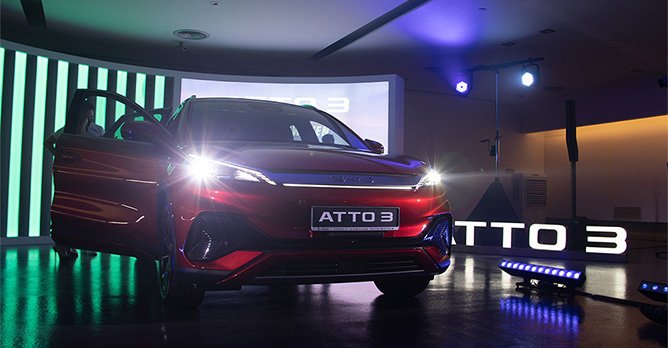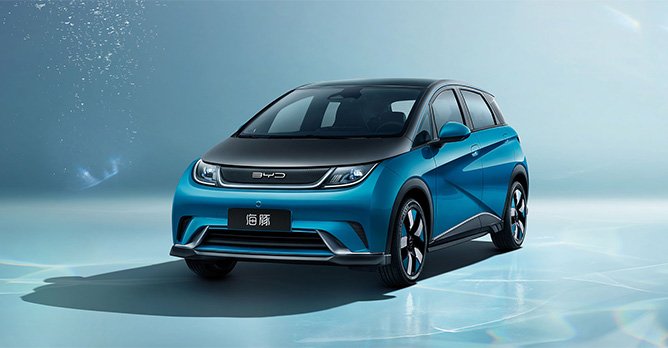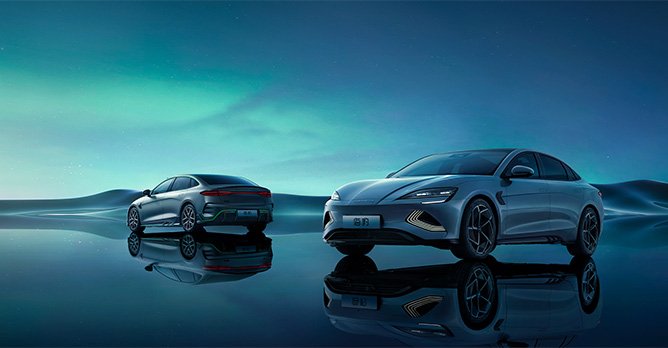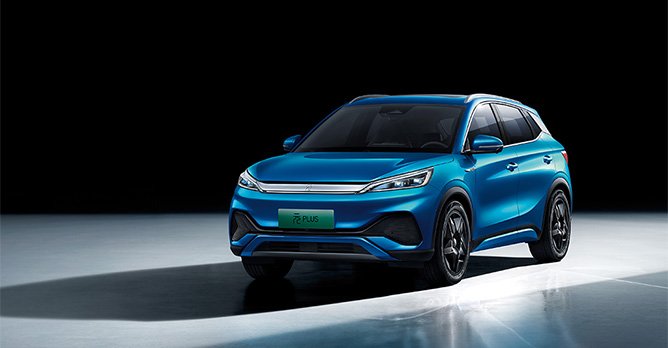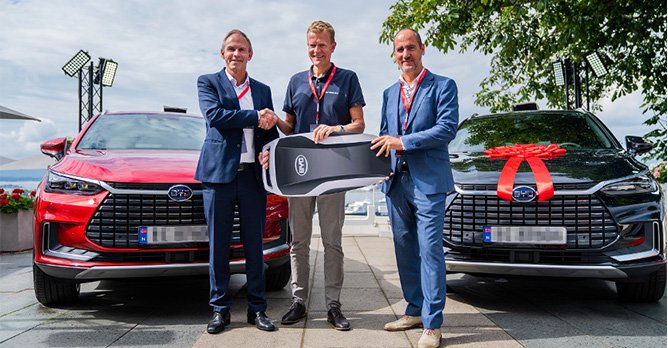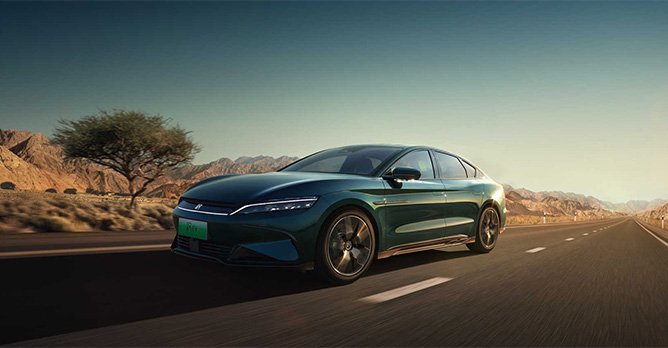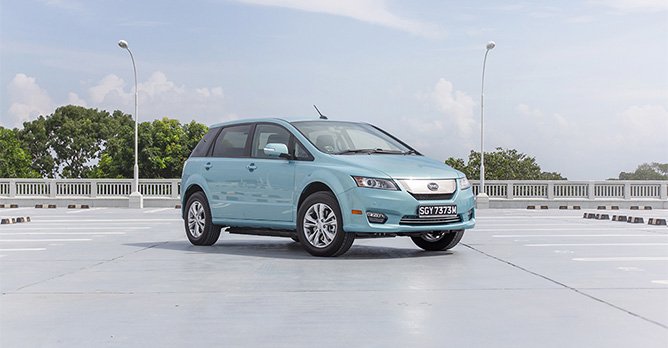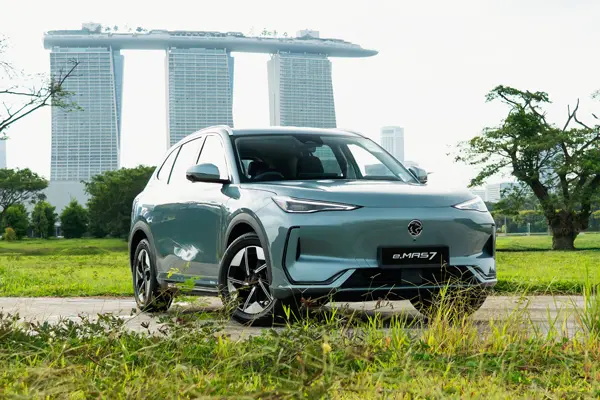It turns out the BYD Atto 3's siblings are just as impressive
15 Jul 2022|12,258 views
We haven't had a thorough experience of the BYD Atto 3 yet (stay tuned for that), but it's undeniable that first impressions for the all-electric SUV have been strong.
On paper, the Atto 3's performance stats and claimed range are incredibly competitive for a mid-range EV. Meanwhile, the literally athletic aesthetic of its interior is a commendable effort at experimentation, regardless of whether it coheres with your Pinterest mood board.
Yet, the fact that Singapore has appeared so taken in and taken by surprise by the Atto 3 is, in turn, evidence of how insulated our market has been from BYD's ever-expanding lineup of EVs.
From marine animal-inspired nameplates to those inspired by China's dynasties, here's a quick round-up of a few notable siblings of the Atto 3 that are worth our attention, presented from two different perspectives.
Probable siblings: Atto 2 and Atto 4
As they say, good things come in threes, and BYD apparently isn't stopping at tacking the Atto prefix onto just a single SUV.
Moving one size down, what's been called the Atto 2 in Australia takes the form of a cutesy supermini, reminiscent of hatches like the Renault Zoe and BMW i3. We mention Australia because it's a close right-hand drive market in which the Atto 3 has been marketed as, well, the Atto 3, and not the Yuan Plus as initially announced. (Confusing, but we'll return to this in a bit. You'll see.)
At just over four metres in length, and close to 1.8 metres wide, the car will be positioned size-wise alongside other city runabouts, such as the Honda Jazz, although with a generous wheelbase of 2,700mm. In China, the Atto 2 gets a 30.7kWh battery in the entry-level variant with an NEDC-rated range of 301km.
Stepping up to higher-spec variants brings in a 44.9kWh battery pack, boosting range to between a claimed 401km and 405km. The most powerful motor can produce 174bhp (130kW) and 290Nm of torque, although a Category A friendly one with 94bhp (70kW) and 180Nm of torque would make more sense in Singapore.
On the other hand, what is likely to be the Atto 4 doesn't just move things up a notch numerically but also from a design standpoint. The slippery fastback sedan shape is increasingly finding favour as manufacturers rush to unveil their EVs, and BYD's own interpretation with the Atto 4 is suitably modern: Replete with flush-fitted door handles and bracket-like head lights.
Measuring 4.8 metres in length and nearly 1.9 metres across, Australian outlets have suggested that this is set to do battle with the Tesla Model 3 and Polestar 2 - and a quick look at the car's specifications will explain why. Available with both rear-wheel (RWD) and all-wheel drive (AWD), the entry-level, single-motor RWD variant already delivers a claimed 550km from a 61.4kWh battery.
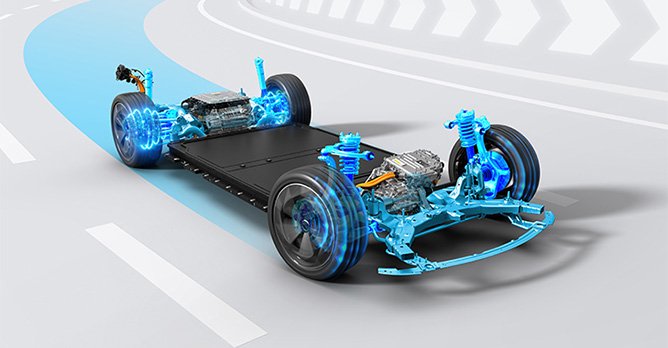
 In its dual-motor, all-wheel drive setup, the Atto 4 will complete the century sprint in just 3.9 seconds Swopping that out for an 82.5kWh battery will apparently bump this up close to 700km. Then, in AWD and with a dual-motor setup for maximum performance, the Atto 4 should do zero to 100km/h in 3.9 seconds.
In its dual-motor, all-wheel drive setup, the Atto 4 will complete the century sprint in just 3.9 seconds Swopping that out for an 82.5kWh battery will apparently bump this up close to 700km. Then, in AWD and with a dual-motor setup for maximum performance, the Atto 4 should do zero to 100km/h in 3.9 seconds.
Like the Atto 3, both the Atto 2 and Atto 4 will be based on BYD's latest e-Platform 3.0. But here's the slight twist: Take a flight to Shanghai when travel restrictions finally lift, and you'll notice that both names (and indeed the Atto 3 too) don't formally exist. Remember that bit about the Yuan Plus? On home-ground, the Atto 2 and 4 are instead named the Dolphin (海豚) and Seal (海豹) respectively, forming part of a new Ocean series of EVs under BYD.
Hold up... Wouldn't that mean that the Atto 3 was meant to stand slightly apart from the Atto 2 and Atto 4 initially?
The actual siblings from the Chinese market's perspective: Tang EV and Han EV
Here, we return to the Atto 3's aforementioned name-change in our attempt to contextualise the Dolphin and Seal monikers. Since 'Yuan Plus' bears no clear association with 'Dolphin' or 'Seal', where does the SUV sit originally?
The answer can be derived from China's history… somewhat. Where 'Yuan Plus' as a nameplate starts to make sense is when it's placed alongside names like 'Song', 'Qin', and indeed 'Han' and 'Tang' - all models in BYD's native lineup paying homage to China's string of dynasties.
Among them, the BYD Tang has already started gaining pace in Europe. Norway remains one of the leading markets for EVs currently, and among its bestsellers for May 2022, BYD's mid-sized SUV overtook competitors like the Volvo C40 and even Tesla Model Y in terms of sales.
Powered again by BYD's Blade Battery, but with 86.4kWh of capacity, the nearly 4.9-metre long Tang manages 400km of range on the stricter WLTP-rating (or about 500-ish km by NEDC standards).
The SUV also supports fast charging at up to 110kW, which sees recharging from 30 to 80% done in just 30 minutes. For some reason, Brembo front brakes are even specced on the car in Norway, which can also seat seven with its wheelbase of 2,820mm.
But the model that will likely set the most bells ringing is the BYD Han EV - arguably the most recognised shape and name from BYD internationally. The Han is the Chinese-maker's flagship, taking on luxury sedan guise not just in terms of design and size (its length is on par with that of the 5 Series and the E-Class), but also features (reclining seats and a fold-down, central touchpad in the rear?) and performance figures.
Like the Atto 4/Seal, dual motors send 485bhp (363kW) to all four wheels in the most powerful variant of the sedan - as well as its two-tonne eclipsing body from zero to 100km/h in just 3.9 seconds. At the same time, its 77kWh battery will still churn out an NEDC-rated 550km of range.
As a fun fact, further reinforcing the argument that the Han, Tang and Atto 3/Yuan Plus all rightfully belong to the same family is the same exterior design language running across the cars.
The Han and Tang were initially released with actual grilles as PHEVs, but in fully-electric form, are fronted by the same 'Dragon Face 3.0', which sees the same DRL-strip tracing the chrome piece on the bonnet from headlight to headlight.
What's likely to come to Singapore next?
If it still isn't clear yet, placing the Atto 3 alongside its siblings helps put into context the strides that BYD has made over the years with the design and quality of its cars. Again, we won't rule out the possibility of our impressions changing slightly once we get to live with the Atto 3 for a few days, but the fact remains that the Chinese maker has long blasted past the era of its boxy and bland first-gen e6.
There's no official word yet on what might come next (also, let's give the Atto 3 and Vantage Automotive some breathing room, shall we?), although our best bets would be on a lineup in Singapore that mirrors what has been slowly trickling into Australia.
Nonetheless, here's an interesting observation we made at the launch of the Atto 3: Four diecast models were on display atop of four white vertical blocks, featuring two BYD Atto 2s/Dolphins… and a BYD Han EV (as well as what looked like the E-SEED GT coupe-concept car that preceded it.)
Will the Chinese luxury flagship reach our shores at some point?
If and when BYD decides (and announces plans) to produce the Han EV in right-hand drive, we'll start getting our hopes up.
For now, though, let the dreaming continue.
Interested in other electric vehicles that haven't reached Singapore yet? These articles may interest you:
Tesla is cool, but check out these 5 EVs that we aren't getting!
Tesla's Model 3 was Singapore's best-selling EV for 2021, but which other cars are electrifying the sales charts globally?
Land Rover meets Tesla: What you need to know about Rivian, the EV-maker that went public last week
On paper, the Atto 3's performance stats and claimed range are incredibly competitive for a mid-range EV. Meanwhile, the literally athletic aesthetic of its interior is a commendable effort at experimentation, regardless of whether it coheres with your Pinterest mood board.
Yet, the fact that Singapore has appeared so taken in and taken by surprise by the Atto 3 is, in turn, evidence of how insulated our market has been from BYD's ever-expanding lineup of EVs.
From marine animal-inspired nameplates to those inspired by China's dynasties, here's a quick round-up of a few notable siblings of the Atto 3 that are worth our attention, presented from two different perspectives.
Probable siblings: Atto 2 and Atto 4
As they say, good things come in threes, and BYD apparently isn't stopping at tacking the Atto prefix onto just a single SUV.
Moving one size down, what's been called the Atto 2 in Australia takes the form of a cutesy supermini, reminiscent of hatches like the Renault Zoe and BMW i3. We mention Australia because it's a close right-hand drive market in which the Atto 3 has been marketed as, well, the Atto 3, and not the Yuan Plus as initially announced. (Confusing, but we'll return to this in a bit. You'll see.)
At just over four metres in length, and close to 1.8 metres wide, the car will be positioned size-wise alongside other city runabouts, such as the Honda Jazz, although with a generous wheelbase of 2,700mm. In China, the Atto 2 gets a 30.7kWh battery in the entry-level variant with an NEDC-rated range of 301km.
Stepping up to higher-spec variants brings in a 44.9kWh battery pack, boosting range to between a claimed 401km and 405km. The most powerful motor can produce 174bhp (130kW) and 290Nm of torque, although a Category A friendly one with 94bhp (70kW) and 180Nm of torque would make more sense in Singapore.
On the other hand, what is likely to be the Atto 4 doesn't just move things up a notch numerically but also from a design standpoint. The slippery fastback sedan shape is increasingly finding favour as manufacturers rush to unveil their EVs, and BYD's own interpretation with the Atto 4 is suitably modern: Replete with flush-fitted door handles and bracket-like head lights.
Measuring 4.8 metres in length and nearly 1.9 metres across, Australian outlets have suggested that this is set to do battle with the Tesla Model 3 and Polestar 2 - and a quick look at the car's specifications will explain why. Available with both rear-wheel (RWD) and all-wheel drive (AWD), the entry-level, single-motor RWD variant already delivers a claimed 550km from a 61.4kWh battery.

Like the Atto 3, both the Atto 2 and Atto 4 will be based on BYD's latest e-Platform 3.0. But here's the slight twist: Take a flight to Shanghai when travel restrictions finally lift, and you'll notice that both names (and indeed the Atto 3 too) don't formally exist. Remember that bit about the Yuan Plus? On home-ground, the Atto 2 and 4 are instead named the Dolphin (海豚) and Seal (海豹) respectively, forming part of a new Ocean series of EVs under BYD.
Hold up... Wouldn't that mean that the Atto 3 was meant to stand slightly apart from the Atto 2 and Atto 4 initially?
The actual siblings from the Chinese market's perspective: Tang EV and Han EV
Here, we return to the Atto 3's aforementioned name-change in our attempt to contextualise the Dolphin and Seal monikers. Since 'Yuan Plus' bears no clear association with 'Dolphin' or 'Seal', where does the SUV sit originally?
The answer can be derived from China's history… somewhat. Where 'Yuan Plus' as a nameplate starts to make sense is when it's placed alongside names like 'Song', 'Qin', and indeed 'Han' and 'Tang' - all models in BYD's native lineup paying homage to China's string of dynasties.
Among them, the BYD Tang has already started gaining pace in Europe. Norway remains one of the leading markets for EVs currently, and among its bestsellers for May 2022, BYD's mid-sized SUV overtook competitors like the Volvo C40 and even Tesla Model Y in terms of sales.
Powered again by BYD's Blade Battery, but with 86.4kWh of capacity, the nearly 4.9-metre long Tang manages 400km of range on the stricter WLTP-rating (or about 500-ish km by NEDC standards).
The SUV also supports fast charging at up to 110kW, which sees recharging from 30 to 80% done in just 30 minutes. For some reason, Brembo front brakes are even specced on the car in Norway, which can also seat seven with its wheelbase of 2,820mm.
But the model that will likely set the most bells ringing is the BYD Han EV - arguably the most recognised shape and name from BYD internationally. The Han is the Chinese-maker's flagship, taking on luxury sedan guise not just in terms of design and size (its length is on par with that of the 5 Series and the E-Class), but also features (reclining seats and a fold-down, central touchpad in the rear?) and performance figures.
Like the Atto 4/Seal, dual motors send 485bhp (363kW) to all four wheels in the most powerful variant of the sedan - as well as its two-tonne eclipsing body from zero to 100km/h in just 3.9 seconds. At the same time, its 77kWh battery will still churn out an NEDC-rated 550km of range.
As a fun fact, further reinforcing the argument that the Han, Tang and Atto 3/Yuan Plus all rightfully belong to the same family is the same exterior design language running across the cars.
The Han and Tang were initially released with actual grilles as PHEVs, but in fully-electric form, are fronted by the same 'Dragon Face 3.0', which sees the same DRL-strip tracing the chrome piece on the bonnet from headlight to headlight.
What's likely to come to Singapore next?
If it still isn't clear yet, placing the Atto 3 alongside its siblings helps put into context the strides that BYD has made over the years with the design and quality of its cars. Again, we won't rule out the possibility of our impressions changing slightly once we get to live with the Atto 3 for a few days, but the fact remains that the Chinese maker has long blasted past the era of its boxy and bland first-gen e6.
There's no official word yet on what might come next (also, let's give the Atto 3 and Vantage Automotive some breathing room, shall we?), although our best bets would be on a lineup in Singapore that mirrors what has been slowly trickling into Australia.
Nonetheless, here's an interesting observation we made at the launch of the Atto 3: Four diecast models were on display atop of four white vertical blocks, featuring two BYD Atto 2s/Dolphins… and a BYD Han EV (as well as what looked like the E-SEED GT coupe-concept car that preceded it.)
Will the Chinese luxury flagship reach our shores at some point?
If and when BYD decides (and announces plans) to produce the Han EV in right-hand drive, we'll start getting our hopes up.
For now, though, let the dreaming continue.
Interested in other electric vehicles that haven't reached Singapore yet? These articles may interest you:
Tesla is cool, but check out these 5 EVs that we aren't getting!
Tesla's Model 3 was Singapore's best-selling EV for 2021, but which other cars are electrifying the sales charts globally?
Land Rover meets Tesla: What you need to know about Rivian, the EV-maker that went public last week
We haven't had a thorough experience of the BYD Atto 3 yet (stay tuned for that), but it's undeniable that first impressions for the all-electric SUV have been strong.
On paper, the Atto 3's performance stats and claimed range are incredibly competitive for a mid-range EV. Meanwhile, the literally athletic aesthetic of its interior is a commendable effort at experimentation, regardless of whether it coheres with your Pinterest mood board.
Yet, the fact that Singapore has appeared so taken in and taken by surprise by the Atto 3 is, in turn, evidence of how insulated our market has been from BYD's ever-expanding lineup of EVs.
From marine animal-inspired nameplates to those inspired by China's dynasties, here's a quick round-up of a few notable siblings of the Atto 3 that are worth our attention, presented from two different perspectives.
Probable siblings: Atto 2 and Atto 4
As they say, good things come in threes, and BYD apparently isn't stopping at tacking the Atto prefix onto just a single SUV.
Moving one size down, what's been called the Atto 2 in Australia takes the form of a cutesy supermini, reminiscent of hatches like the Renault Zoe and BMW i3. We mention Australia because it's a close right-hand drive market in which the Atto 3 has been marketed as, well, the Atto 3, and not the Yuan Plus as initially announced. (Confusing, but we'll return to this in a bit. You'll see.)
At just over four metres in length, and close to 1.8 metres wide, the car will be positioned size-wise alongside other city runabouts, such as the Honda Jazz, although with a generous wheelbase of 2,700mm. In China, the Atto 2 gets a 30.7kWh battery in the entry-level variant with an NEDC-rated range of 301km.
Stepping up to higher-spec variants brings in a 44.9kWh battery pack, boosting range to between a claimed 401km and 405km. The most powerful motor can produce 174bhp (130kW) and 290Nm of torque, although a Category A friendly one with 94bhp (70kW) and 180Nm of torque would make more sense in Singapore.
On the other hand, what is likely to be the Atto 4 doesn't just move things up a notch numerically but also from a design standpoint. The slippery fastback sedan shape is increasingly finding favour as manufacturers rush to unveil their EVs, and BYD's own interpretation with the Atto 4 is suitably modern: Replete with flush-fitted door handles and bracket-like head lights.
Measuring 4.8 metres in length and nearly 1.9 metres across, Australian outlets have suggested that this is set to do battle with the Tesla Model 3 and Polestar 2 - and a quick look at the car's specifications will explain why. Available with both rear-wheel (RWD) and all-wheel drive (AWD), the entry-level, single-motor RWD variant already delivers a claimed 550km from a 61.4kWh battery.

 In its dual-motor, all-wheel drive setup, the Atto 4 will complete the century sprint in just 3.9 seconds Swopping that out for an 82.5kWh battery will apparently bump this up close to 700km. Then, in AWD and with a dual-motor setup for maximum performance, the Atto 4 should do zero to 100km/h in 3.9 seconds.
In its dual-motor, all-wheel drive setup, the Atto 4 will complete the century sprint in just 3.9 seconds Swopping that out for an 82.5kWh battery will apparently bump this up close to 700km. Then, in AWD and with a dual-motor setup for maximum performance, the Atto 4 should do zero to 100km/h in 3.9 seconds.
Like the Atto 3, both the Atto 2 and Atto 4 will be based on BYD's latest e-Platform 3.0. But here's the slight twist: Take a flight to Shanghai when travel restrictions finally lift, and you'll notice that both names (and indeed the Atto 3 too) don't formally exist. Remember that bit about the Yuan Plus? On home-ground, the Atto 2 and 4 are instead named the Dolphin (海豚) and Seal (海豹) respectively, forming part of a new Ocean series of EVs under BYD.
Hold up... Wouldn't that mean that the Atto 3 was meant to stand slightly apart from the Atto 2 and Atto 4 initially?
The actual siblings from the Chinese market's perspective: Tang EV and Han EV
Here, we return to the Atto 3's aforementioned name-change in our attempt to contextualise the Dolphin and Seal monikers. Since 'Yuan Plus' bears no clear association with 'Dolphin' or 'Seal', where does the SUV sit originally?
The answer can be derived from China's history… somewhat. Where 'Yuan Plus' as a nameplate starts to make sense is when it's placed alongside names like 'Song', 'Qin', and indeed 'Han' and 'Tang' - all models in BYD's native lineup paying homage to China's string of dynasties.
Among them, the BYD Tang has already started gaining pace in Europe. Norway remains one of the leading markets for EVs currently, and among its bestsellers for May 2022, BYD's mid-sized SUV overtook competitors like the Volvo C40 and even Tesla Model Y in terms of sales.
Powered again by BYD's Blade Battery, but with 86.4kWh of capacity, the nearly 4.9-metre long Tang manages 400km of range on the stricter WLTP-rating (or about 500-ish km by NEDC standards).
The SUV also supports fast charging at up to 110kW, which sees recharging from 30 to 80% done in just 30 minutes. For some reason, Brembo front brakes are even specced on the car in Norway, which can also seat seven with its wheelbase of 2,820mm.
But the model that will likely set the most bells ringing is the BYD Han EV - arguably the most recognised shape and name from BYD internationally. The Han is the Chinese-maker's flagship, taking on luxury sedan guise not just in terms of design and size (its length is on par with that of the 5 Series and the E-Class), but also features (reclining seats and a fold-down, central touchpad in the rear?) and performance figures.
Like the Atto 4/Seal, dual motors send 485bhp (363kW) to all four wheels in the most powerful variant of the sedan - as well as its two-tonne eclipsing body from zero to 100km/h in just 3.9 seconds. At the same time, its 77kWh battery will still churn out an NEDC-rated 550km of range.
As a fun fact, further reinforcing the argument that the Han, Tang and Atto 3/Yuan Plus all rightfully belong to the same family is the same exterior design language running across the cars.
The Han and Tang were initially released with actual grilles as PHEVs, but in fully-electric form, are fronted by the same 'Dragon Face 3.0', which sees the same DRL-strip tracing the chrome piece on the bonnet from headlight to headlight.
What's likely to come to Singapore next?
If it still isn't clear yet, placing the Atto 3 alongside its siblings helps put into context the strides that BYD has made over the years with the design and quality of its cars. Again, we won't rule out the possibility of our impressions changing slightly once we get to live with the Atto 3 for a few days, but the fact remains that the Chinese maker has long blasted past the era of its boxy and bland first-gen e6.
There's no official word yet on what might come next (also, let's give the Atto 3 and Vantage Automotive some breathing room, shall we?), although our best bets would be on a lineup in Singapore that mirrors what has been slowly trickling into Australia.
Nonetheless, here's an interesting observation we made at the launch of the Atto 3: Four diecast models were on display atop of four white vertical blocks, featuring two BYD Atto 2s/Dolphins… and a BYD Han EV (as well as what looked like the E-SEED GT coupe-concept car that preceded it.)
Will the Chinese luxury flagship reach our shores at some point?
If and when BYD decides (and announces plans) to produce the Han EV in right-hand drive, we'll start getting our hopes up.
For now, though, let the dreaming continue.
Interested in other electric vehicles that haven't reached Singapore yet? These articles may interest you:
Tesla is cool, but check out these 5 EVs that we aren't getting!
Tesla's Model 3 was Singapore's best-selling EV for 2021, but which other cars are electrifying the sales charts globally?
Land Rover meets Tesla: What you need to know about Rivian, the EV-maker that went public last week
On paper, the Atto 3's performance stats and claimed range are incredibly competitive for a mid-range EV. Meanwhile, the literally athletic aesthetic of its interior is a commendable effort at experimentation, regardless of whether it coheres with your Pinterest mood board.
Yet, the fact that Singapore has appeared so taken in and taken by surprise by the Atto 3 is, in turn, evidence of how insulated our market has been from BYD's ever-expanding lineup of EVs.
From marine animal-inspired nameplates to those inspired by China's dynasties, here's a quick round-up of a few notable siblings of the Atto 3 that are worth our attention, presented from two different perspectives.
Probable siblings: Atto 2 and Atto 4
As they say, good things come in threes, and BYD apparently isn't stopping at tacking the Atto prefix onto just a single SUV.
Moving one size down, what's been called the Atto 2 in Australia takes the form of a cutesy supermini, reminiscent of hatches like the Renault Zoe and BMW i3. We mention Australia because it's a close right-hand drive market in which the Atto 3 has been marketed as, well, the Atto 3, and not the Yuan Plus as initially announced. (Confusing, but we'll return to this in a bit. You'll see.)
At just over four metres in length, and close to 1.8 metres wide, the car will be positioned size-wise alongside other city runabouts, such as the Honda Jazz, although with a generous wheelbase of 2,700mm. In China, the Atto 2 gets a 30.7kWh battery in the entry-level variant with an NEDC-rated range of 301km.
Stepping up to higher-spec variants brings in a 44.9kWh battery pack, boosting range to between a claimed 401km and 405km. The most powerful motor can produce 174bhp (130kW) and 290Nm of torque, although a Category A friendly one with 94bhp (70kW) and 180Nm of torque would make more sense in Singapore.
On the other hand, what is likely to be the Atto 4 doesn't just move things up a notch numerically but also from a design standpoint. The slippery fastback sedan shape is increasingly finding favour as manufacturers rush to unveil their EVs, and BYD's own interpretation with the Atto 4 is suitably modern: Replete with flush-fitted door handles and bracket-like head lights.
Measuring 4.8 metres in length and nearly 1.9 metres across, Australian outlets have suggested that this is set to do battle with the Tesla Model 3 and Polestar 2 - and a quick look at the car's specifications will explain why. Available with both rear-wheel (RWD) and all-wheel drive (AWD), the entry-level, single-motor RWD variant already delivers a claimed 550km from a 61.4kWh battery.

Like the Atto 3, both the Atto 2 and Atto 4 will be based on BYD's latest e-Platform 3.0. But here's the slight twist: Take a flight to Shanghai when travel restrictions finally lift, and you'll notice that both names (and indeed the Atto 3 too) don't formally exist. Remember that bit about the Yuan Plus? On home-ground, the Atto 2 and 4 are instead named the Dolphin (海豚) and Seal (海豹) respectively, forming part of a new Ocean series of EVs under BYD.
Hold up... Wouldn't that mean that the Atto 3 was meant to stand slightly apart from the Atto 2 and Atto 4 initially?
The actual siblings from the Chinese market's perspective: Tang EV and Han EV
Here, we return to the Atto 3's aforementioned name-change in our attempt to contextualise the Dolphin and Seal monikers. Since 'Yuan Plus' bears no clear association with 'Dolphin' or 'Seal', where does the SUV sit originally?
The answer can be derived from China's history… somewhat. Where 'Yuan Plus' as a nameplate starts to make sense is when it's placed alongside names like 'Song', 'Qin', and indeed 'Han' and 'Tang' - all models in BYD's native lineup paying homage to China's string of dynasties.
Among them, the BYD Tang has already started gaining pace in Europe. Norway remains one of the leading markets for EVs currently, and among its bestsellers for May 2022, BYD's mid-sized SUV overtook competitors like the Volvo C40 and even Tesla Model Y in terms of sales.
Powered again by BYD's Blade Battery, but with 86.4kWh of capacity, the nearly 4.9-metre long Tang manages 400km of range on the stricter WLTP-rating (or about 500-ish km by NEDC standards).
The SUV also supports fast charging at up to 110kW, which sees recharging from 30 to 80% done in just 30 minutes. For some reason, Brembo front brakes are even specced on the car in Norway, which can also seat seven with its wheelbase of 2,820mm.
But the model that will likely set the most bells ringing is the BYD Han EV - arguably the most recognised shape and name from BYD internationally. The Han is the Chinese-maker's flagship, taking on luxury sedan guise not just in terms of design and size (its length is on par with that of the 5 Series and the E-Class), but also features (reclining seats and a fold-down, central touchpad in the rear?) and performance figures.
Like the Atto 4/Seal, dual motors send 485bhp (363kW) to all four wheels in the most powerful variant of the sedan - as well as its two-tonne eclipsing body from zero to 100km/h in just 3.9 seconds. At the same time, its 77kWh battery will still churn out an NEDC-rated 550km of range.
As a fun fact, further reinforcing the argument that the Han, Tang and Atto 3/Yuan Plus all rightfully belong to the same family is the same exterior design language running across the cars.
The Han and Tang were initially released with actual grilles as PHEVs, but in fully-electric form, are fronted by the same 'Dragon Face 3.0', which sees the same DRL-strip tracing the chrome piece on the bonnet from headlight to headlight.
What's likely to come to Singapore next?
If it still isn't clear yet, placing the Atto 3 alongside its siblings helps put into context the strides that BYD has made over the years with the design and quality of its cars. Again, we won't rule out the possibility of our impressions changing slightly once we get to live with the Atto 3 for a few days, but the fact remains that the Chinese maker has long blasted past the era of its boxy and bland first-gen e6.
There's no official word yet on what might come next (also, let's give the Atto 3 and Vantage Automotive some breathing room, shall we?), although our best bets would be on a lineup in Singapore that mirrors what has been slowly trickling into Australia.
Nonetheless, here's an interesting observation we made at the launch of the Atto 3: Four diecast models were on display atop of four white vertical blocks, featuring two BYD Atto 2s/Dolphins… and a BYD Han EV (as well as what looked like the E-SEED GT coupe-concept car that preceded it.)
Will the Chinese luxury flagship reach our shores at some point?
If and when BYD decides (and announces plans) to produce the Han EV in right-hand drive, we'll start getting our hopes up.
For now, though, let the dreaming continue.
Interested in other electric vehicles that haven't reached Singapore yet? These articles may interest you:
Tesla is cool, but check out these 5 EVs that we aren't getting!
Tesla's Model 3 was Singapore's best-selling EV for 2021, but which other cars are electrifying the sales charts globally?
Land Rover meets Tesla: What you need to know about Rivian, the EV-maker that went public last week
Thank You For Your Subscription.
















